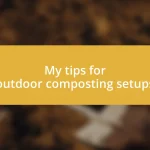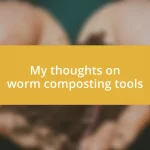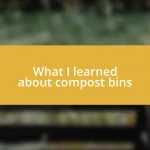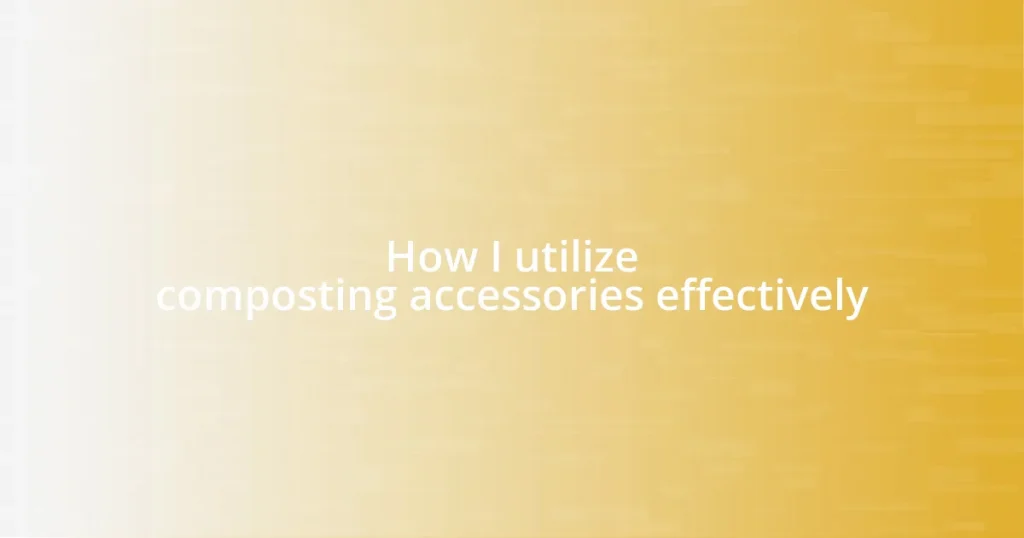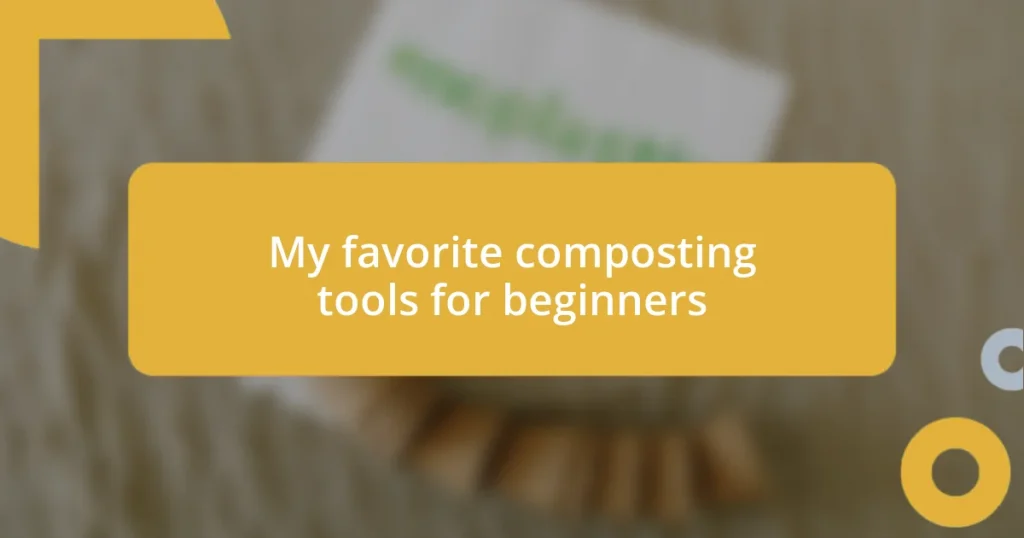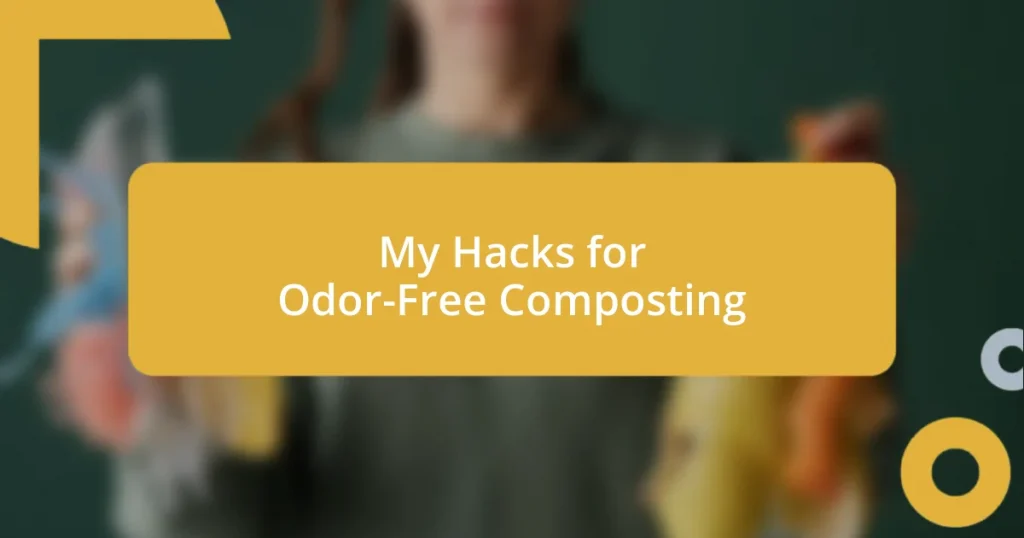Key takeaways:
- Essential tools for worm composting include a worm bin, bedding materials, composting worms, a moisture meter, and a pH testing kit to ensure a healthy environment for worms.
- Advanced tools like compost aerators, digital temperature gauges, and worm composting tumblers enhance efficiency and effectiveness in the composting process.
- Regular maintenance tools, such as a hand trowel, spray bottle, and fine mesh sieve, are necessary for keeping a thriving worm colony and managing compost quality.

Introduction to worm composting tools
When I first discovered worm composting, I was amazed by how simple yet effective it could be. The right tools can transform a kitchen full of scraps into nutrient-rich compost, and every gardener knows that healthy soil equals vibrant plants. Have you ever wondered what tools you truly need to get started?
A worm composting system typically includes a bin, bedding materials, and of course, your worms. I remember my excitement the day I set up my first bin – it felt like embarking on a new adventure! Each tool plays a role in creating a thriving ecosystem, so understanding their purpose can truly elevate your experience.
Not all composting tools are created equal, and finding the ones that resonate with your style can be a journey in itself. Some prefer stackable bins for space efficiency, while others enjoy the simplicity of a single bin. Reflecting on my own journey, I appreciate how these choices can influence not just the process, but also the joy of nurturing a vibrant worm community.

Essential tools for worm composting
When setting up a worm composting system, I’ve found that having the right tools makes a world of difference. The essential items you need are not just functional; they can also make the whole process enjoyable! Here are the tools I consider indispensable:
- Worm bin: This is where the magic happens! Whether you choose a plastic bin or a wooden one, make sure it has drainage holes.
- Bedding materials: Shredded newspaper, cardboard, and coconut coir are all excellent choices. I love using shredded newspaper—it’s a great way to repurpose something that would otherwise go to waste.
- Composting worms: Red wigglers are the most popular choice. Their voracious appetite for food scraps always amazes me.
- Moisture meter: Maintaining the right humidity is crucial. I remember the first time I neglected this—my worms were not happy!
- pH testing kit: A simple way to monitor the acidity of your compost. Keeping it around neutral helps your worms thrive.
With these essential tools in place, your journey in worm composting will be both satisfying and fruitful. I can’t stress enough how important it is to observe and make adjustments based on what your worms need; it’s like getting to know a new friend!

Advanced tools for efficient composting
As I delved deeper into worm composting, I discovered advanced tools that significantly enhanced the efficiency of the process. One prime example is a compost aerator. This tool keeps the compost well-oxygenated, which is crucial for optimal decomposition. It’s incredible how a simple twist and pull can invigorate your worm colony! I remember the first time I used one—it felt like I was giving my compost a refreshing breath of fresh air.
Another game-changer for me was investing in a digital temperature gauge. Monitoring the internal temperature of the compost makes a huge difference. I felt relieved knowing I could quickly check if things were heating up too much, which can be detrimental to the worms. I can’t stress enough how that little gadget provided me peace of mind!
Lastly, there are specialized worm composting tumblers. They offer a unique way to manage your compost, allowing for easier mixing and aeration. I vividly recall the first time I rolled mine—seeing everything blend together felt like watching a miniature ecosystem at work. Each of these tools has brought me more joy and success in my composting journey.
| Tool | Purpose |
|---|---|
| Compost Aerator | Improves oxygenation, promoting effective decomposition. |
| Digital Temperature Gauge | Monitors internal compost temperature for optimal conditions. |
| Worm Composting Tumbler | Facilitates mixing and aeration for a balanced compost pile. |

Maintenance tools for healthy worms
To keep your worm colony thriving, regular maintenance tools are essential. In my experience, a sturdy hand trowel is invaluable for mixing the bedding and compost. It’s a small tool that packs a punch. The first time I used one, I realized how much easier it made my life; no longer did I have to struggle through layers of material with my hands!
I also can’t undervalue a good sprayer for maintaining moisture levels. Have you ever seen worms squirming because the bedding was too dry? I certainly have, and it broke my heart. Once I started using a simple spray bottle, I could easily encourage that perfect humidity. It’s almost like nurturing a garden—your worms thrive when you care for their environment.
Lastly, I swear by a fine mesh sieve for sorting out finished compost from bedding. Initially, I used my hands, and it felt messy and tedious. Once I switched to using a sieve, it became a breeze! I enjoy the satisfaction of seeing the rich, dark compost fall away while ensuring my worms remain undisturbed. It’s such a rewarding feeling to see the fruits of your labor!



